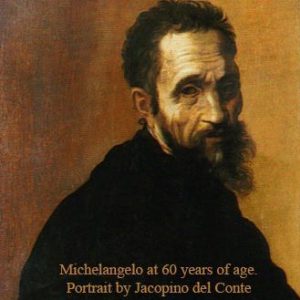There is only a few specialists in Renaissance studies today take seriously the theology of the Renaissance or the work of Michelangelo. Most writers want you to believe their fairy tail ‘pagan’ Renaissance, but this is merely a creation of 18th century historians.
Why should we care? If we want to understand what is going on in a painting by Michelangelo or anyone else, we need to know what principles they held – what did they believe?
Michelangelo, the Theologian
Saints were painted pretty to show their Sanctifying Grace; sinners were painted ugly to express their inner spiritual state. Catholic theology of the 15th and 16th centuries relied mainly on St. Thomas Aquinas and the Dominicans. The Dominicans were everywhere; they were artists like Fra Angelico, and they were doctors. They were scientists – and they were theologians, like Savonarola.
 Savonarola, Michelangelo knew his work.
Savonarola, Michelangelo knew his work.
Many people were convinced at this time that the end of the world was at hand: St. Vincent Ferrer preached it in France. Savonarola did all he could to convince his followers to change their lives, repent from sin, the end is at hand! Michelangelo was a fan of Savonarola, and quoted him 50 years after his death.
Well read and a fair theologian, Michelangelo was also an artist, and thought, wrote and acted as an artist. There is a famous story of someone who had asked him how he got such beautiful statues from a huge block of stone. He responded with something like, “I just imagine the image that is in there, and chip away at the rest!”.
Michelangelo was not a Platonist! He simply spoke the way an artist would speak. ‘Here is a fan, he must be entertained, let me say something witty that does not reveal the true nature of my work!’
Michelangelo, like Raphael, were both forgotten after their deaths. He, more than Raphael, because much of his work is more confined to architecture or is simply otherwise unmovable.
Dramatic Changes in the 1700’s
In the 1700’s we begin to see a dramatic change in the way art and artists were portrayed. Critics started ransacking the ancient stories to find examples of ‘noble virtue’ in the pagan world. Johann Joachim Winckelmann (1717-1768), converted to the Catholic faith to be placed in charge of the antiquities of the Vatican museums. His conversion wasn’t sincere; we know from his personal letters that he only converted to get into the collection. He was homosexual, and couldn’t see anything good coming from the Catholic Church – art or otherwise.
John Addington Symonds (1840-1893) was a British Gay Activist. He was the first to recall the relations of some ancient Greek men and boys. He wrote “Male Love”, published in 1883. He claimed that the grand-nephew of Michelangelo had changed the pronouns of some of his poems, so that Michelangelo’s love for ‘all things Greek’, might remain hidden. Symonds claimed to have gotten the ‘original’ autographs of Michelangelo, and translated them ‘correctly’. Coincidentally, Henry Wadsworth Longfellow also translated some poetry of Michelangelo, and these were also published the same year – 1883. Longfellow doesn’t mention anything about Michelangelo’s presumed sexual preferences.
Michelangelo’s alleged list of loves grows and grows, depending on your source. A short-list would be: Febo da Poggio, Gherardo Perini, Tommaso dei Cavalieri (with 300 verses or poems), Cecchino dei Bracci (with 50 verses).
Refuting the Charges
Cecchino died at the age of 16. Apparently a very popular guy, his friends asked Michelangelo to design his tomb. He did, and also wrote a bunch of 4 line stanza’s for the tomb. Cecchino is seen in Michelangelo’s poem (G.193), where Michelangelo laments that he never really had a chance to know him. He states: Scarce had I seen for the first time his eyes, Which to your living eyes were life and light, When, closed at last in death’s injurious night, He opened then on God in Paradise.
Then, there is the letter Michelangelo wrote to a friend complaining about someone who wanted to open a workshop (bottega) right next to his. Michelangelo referred to this as “being in his bed” (Note to self: Never use a play on words or metaphors in your writings, or it will come back to haunt you).
Art critics, beginning in the 18th century, wanted to divorce the Church from the artwork it produced, and nothing says “not aligned with Catholic doctrine” like claiming an artist is homosexual. These critics claim that art remained attached to the Church, but it began to develop around principles that have no content with religious duties. The religious content – shunning the evils in life – is such an essentially negative character, that artists became more creative as they separated themselves more (spiritually and emotionally) from the Church.
 James Burckhart, believed Michelangelo was divorced from the Church.
James Burckhart, believed Michelangelo was divorced from the Church.
“Artists”, it is claimed “are producing great art during the Renaissance because they are divorced from the Church – they are ‘free’.” James Burckhardt (1818-1897), a big proponent of this idea, believed that “Jesus is a myth”. Was Jesus a myth to Michelangelo? Michelangelo spent the last years of his life making stating like, “nothing is important, other than contemplating Jesus and the Cross”. What one has practiced in life, one has become very good at by the time they die.
If you want to understand the minds and hearts of the artists of the Renaissance, I would suggest a book like Religious Symbolism of Michelangelo, The Sistine Ceiling, by Edgar Wind.




